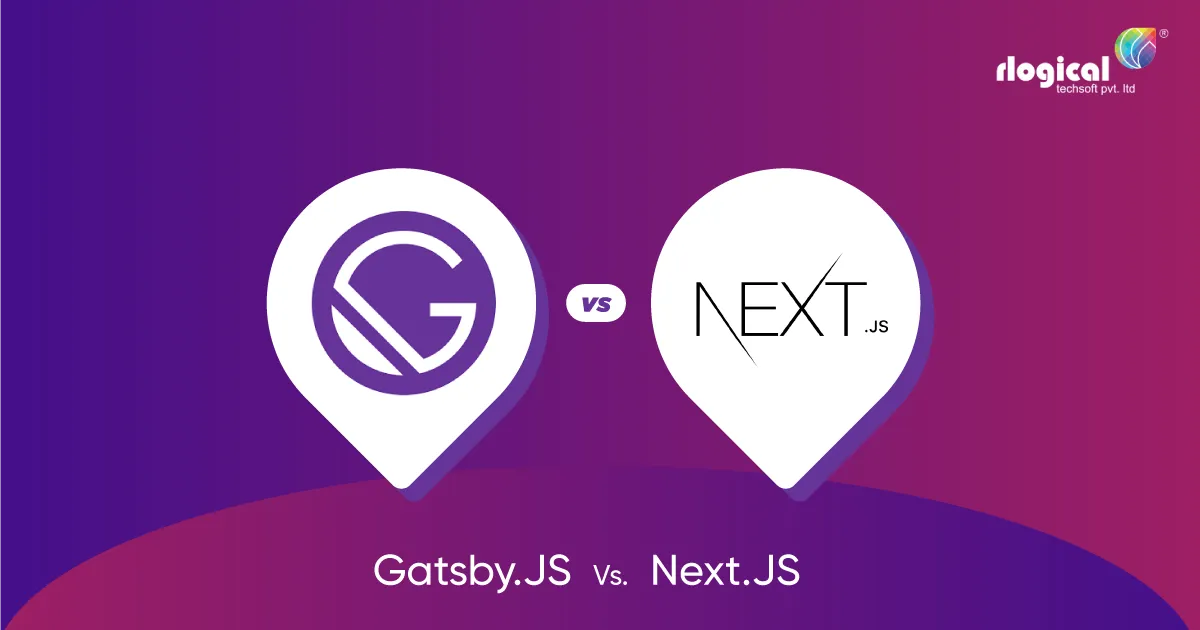
Comparative analysis between different technologies is quite obvious whenever anything new surfaces. Such comparative analyses are way lot active in this era of digitization. From this perspective, the comparison between GatsbyJS and that of NextJS is quite obvious. The popularity of Gatsby.JS and Next.JS development services have significantly grown as these technologies are massively used to power complex websites looking forward to enhancing their speed and attaining a greater ranking. The following abstracts throw more light into the comparative analysis between the both.
Gatsby.JS

Gatsby.JS is mostly meant for developing websites generating static HTML upfront that can be kept on CDNs worldwide to facilitate swifter access. It combines the best aspects of React and GraphQL and react-router to obtain a site generator that can be more user-friendly for the developers.
Specifically, the technology is highly favored among companies associated with ReactJS Development Services. This is a contemporary framework meant for front-end works that facilitate super fast loading of pages. With the Gatsby ecosystem, the developer has the scope to select multiple ways of developing a website. Following are some of the key advantages that a developer can enjoy through GatsbyJS.
Pros of Gatsby.JS
- Sites developed with Gatsby JS are expected to be a minimum of three times faster than others of its kind.
- After a developer develops the source code, Gatsby handles the other aspects simply by compiling the most effective Webpack configuration for developing a website.
- This meets well with the PRPL pattern of Google that can enhance a site’s performance over any smartphone.
- There is no scope for direct connectivity through Gatsby.JS with the database, dependencies, data of the user, and other crucial details. This assures the greater security of the website.
- By keeping the costs low associated with hosting or update, it boosts profitability.
- Enriched with high-end plugins and themes, one can build web app using Gatsby.JS within a few minutes.
Must Read: Why Make Use of Gatsby.js for Your Subsequent Project?
Next.JS

Coming to Next.JS, it is meant for developing websites that are rendered server-side that dynamically develop HTML using a server at every occasion of new request receipt. In addition, it supports static page development, CDN caching, and the advantages of static page development. This is why Next.JS is regarded as the best tool for setting dynamic websites facilitating smooth server interactions.
It makes use of Hot Code to let the developers develop catchy React websites. In general, Next.JS is utilized on those occasions when one needs a site supporting SSR and optimization of static pages. It also provides a greater scope of developing applications and doesn’t pack unwanted tools. Those looking forward to developing high-end applications can find it an incredible framework.
Pros of Next.JS
- Next.JS renders websites server-side, which means the HTML is delivered when a client’s request is received. It means that one can create a page dynamically as per the data provided through the request.
- Next.JS thoroughly supports static page development at the time of development for delivering the greater result.
- This is quite smart to deliver both the CSS as well as JavaScript essential for a specific page. It boosts the performance of the page, enabling the user to view the content page faster.
- Next.JS provides the HMR benefits to the developer. This helps then in evidencing the whole range of changes being made through development, very much live in the app itself, immediately when these are carried out.
- Next.JS provides a variety of components that can be immediately used, which hasten the development of MVPs.
Must Read: Difference Between Next.js vs. Nuxt.js vs. Nest.js
Comparative Analysis Between the Next.JS-Gatsby.JS

- The basic difference between Next.JS and Gatsby.JS is that the Next.JS demands a server for its functionality, especially when it comes to enabling the features of SSR. On the other hand, Gatsby can function well without any server.
- Next.JS can create HTML or JS, or CSS at the runtime itself. On the other hand, Gatsby develops authentic HTML or JS or CSS at the time of development.
- Moreover, Gatsby is a tool for creating a static site, Next.JS primarily is one hybrid tool that renders pages at the server-side, and it’s a static site creator.
- As far as data handling is concerned, the decision remains entirely upon the user in the case of Next.JS. Whereas Gatsby depicts users about the way, they should deal with the data within the app.
- As Gatsby is more focused on a plug-in that can be smoothly adjusted and provides a huge variety of themes or templates, the approach of developing a comprehensive application is much faster in the case of Gatsby, in comparison to Next.JS.
Conclusion
All said and done; both these frameworks are equally impressive. It means that the users need to be more careful about their requirements to avoid confusion about selecting. Where Gatsby is the best recommendation for static sites, Next.JS is moreover a server-side site.
Rahul Panchal
Rahul Panchal is the Founder & Managing Director at Rlogical Techsoft Pvt. Ltd. He is a pioneer tech enthusiast who has assisted diverse enterprise solutions with a fresh perspective over the years. From integrating technologies like Full-Stack, .NET, Flutter & PHP, he has harnessed custom web or hybrid mobile app development projects. His creative outlook on the latest models of AI, ML, blockchain, and IoT, has made various businesses attain leading-edge success.
Related Blog
- A Guide on Progressive Web App with React: The Long-Term Solution for Business Growth
- Top JavaScript Frameworks For Your Web Applications Project
- Why Use VueJS? Most Popular Frontend Framework for Your Web Development
- Create Appealing Real-Time Applications with NodeJS: The JavaScript Edge for Apps
- Top Apps Built With Node.js: The Success Story of NodeJS
Categories
- All
- AI Development Services
- Amazon Web Services (AWS)
- ASP.Net Development
- Azure Web App
- Big Data Analytic
- Customize
- Digital Marketing
- Drupal Development
- E-commerce web development
- Education Mobile App Development
- Enterprise Application
- Event Management App Development
- Fintech
- Fitness App Development
- Food Delievery
- Front-End Development
- Grocery App Development
- Healthcare App Development
- Hire Dedicated Developers
- Hotel Booking App
- IT Industry
- JavaScript Development
- Mobile App Development
- On Demand App Development
- On Demand Healthcare App Development
- PHP Development
- POS Software Development
- Real Estate Mobile App Development
- Retail Business App Development
- Salesforce
- Social Media Development
- Software Development
- Technology
- Transportation App Development
- UI/UX Design
- Web Design
- Web Development
- Web Services
- Web/Data Scraping Services
- WordPress




 Rahul Panchal in JavaScript Development
Rahul Panchal in JavaScript Development 





